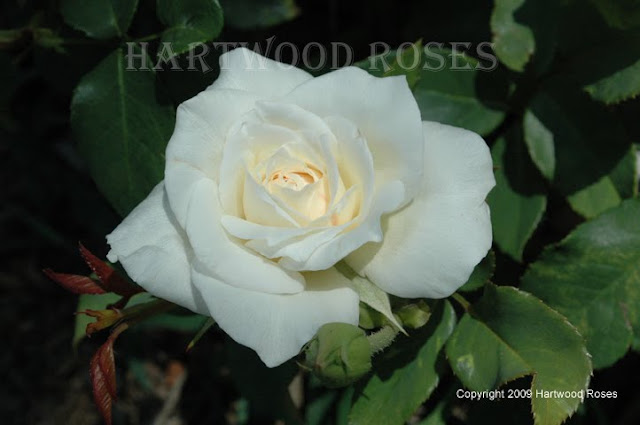I haven't worked in the garden at all this week. Last week's rain left the ground too soggy to plant anything, and I didn't feel like weeding or mulching ... both of which desperately need to be done, BTW. A garden club friend yesterday asked me, "Are you ready for winter?" Not on your life, was my answer. He smiled.
So, I spent a couple of days planting the last of my cuttings and putting them on the propagation table in the greenhouse to (hopefully) grow roots and become new roses. These cuttings are my final push to balance the selection of roses for next year. We'll see how well they root and if I succeed in having a well-rounded inventory of roses among the various classes.
For this week's Friday Flowers I'll show you some of the roses that you can expect to find here for sale next year, concentrating on the pink ones. (We'll do another color next week.) Enjoy!
Union Redwood Cemetery, Hybrid Perpetual, found rose. This rose was discovered in California, in Union Redwood Cemetery (need I say 'duh'?). It is one of the most floriforous hybrid perpetual in my collection. Most HPs bloom beautifully for their first flush in the spring, take the summer off, and produce a flower or two in the fall. Union Redwood had at least one flower on it for most of the summer, and produced a modest flush of bloom in October ... and, like most HPs, it's fragrant.
La Marne, Polyantha, 1915. I showed you a full-bush photo of La Marne in this post about roses in full bloom in October. From the time La Marne started blooming in May, until today, there has never been a time that it is without flowers. Never.
New Dawn, Climber, 1930. What can I say about New Dawn that hasn't already been said over and over. It's a great climbing rose with well-deserved popularity ... and it's the parent of a whole race of other great climbers.
Pink Gruss an Aachen, Polyantha, 1929. Pink Gruss, like its paler-colored sport parent Gruss an Aachen, makes a tidy, rounded shrub, with large, shiny, dark green leaves ... covered with flowers in the spring and throughout the summer into fall. It attracts a LOT of attention from visitors, because the flowers resemble peonies.
(For those who are unfamiliar with the term, a 'sport' is a mutation that causes a portion of a plant to look or behave differently from the rest of the plant.)
Albertine, Hybrid Wichuriana rambler, 1921. Albertine lives on my rambler fence, and she's wonderful. She's not as stringy and flexible as some of the ramblers I grow, and I find that it's best to train her into a fan shape because her canes are so stiff. This little bit of effort rewards me with masses of flowers in May and June.

Baltimore Belle (pink version), Hybrid Setigera rambler, 1843. Baltimore Belle is said to have pink buds that open to a creamy, pink-white. The flowers on my version which came from the Old City Cemetery in Lynchburg, stay pink. We have agreement among some rose experts I know (that stood and stared and discussed this rose here last summer) that the rose in my garden is probably not the original Baltimore Belle ... it appears to be identical to another rose I grow here called "Arcata Pink Globe" (a mystery rose discovered in California). Regardless of its ultimate ID, this rambler is one of the healthiest, showiest ones I have here. I grow it in the corner of the Rose Field fence, so I can spread its canes out in three directions.
Felicia, Hybrid Musk, 1928. Felicia grows to form a tall, upright shrub that can easily reach 8 feet tall. This is good, because her clusters of flowers tend to nod downward gracefully. I use Felicia whenever I need an example of an extremely fragrant rose.
Jean Bach Sisley, China rose, 1898. I think there has to be some tea rose in Jean Bach Sisley, because her lovely buds open to graceful, tea-shaped flowers. She has the twiggy structure of a China, however, and she holds her flowers in clusters above the main structure of the bush. Her new growth is red-purple, like both Teas and Chinas, and she will eventually build into a fairly large shrub.
Lady of the Dawn, Floribunda, 1984. I had never heard of this rose before I bought it. I thought the name was appropriate for me, because I'm such an early riser. I love the semi-double flowers with their yellow stamens. Other people must like this rose, too, because there were quite a few of them exhibited in the Floribunda class at the District rose show in September.
La France, Hybrid Tea, 1867. No collection of antique Hybrid Tea roses would be complete without the rose that is considered to be the first member of that class. La France is planted front and center in Hybrid Tea bed in front of the house, and she performs well enough for me to deserve this prime location.
Mlle. Augustine Guinoisseau, Hybrid Tea, 1899 ... also known as 'White La France'. Mlle. Augustine has all the characteristics of La France, her sport parent, with pale silvery-pink flowers.
Sarah Van Fleet, Hybrid Rugosa, 1926. I'll finish my show and tell this Friday with a rose from one of my favorite hybridizers, Dr. Walter Van Fleet. I could go on and on about why I admire this man and the roses he created (I'm trying to get my hands on every one of them, if I can.) This rose is named for his wife, Sarah, and it deserves the honor.
This Friday is sunny and mild here, and I am going to work outside for a while.


































































